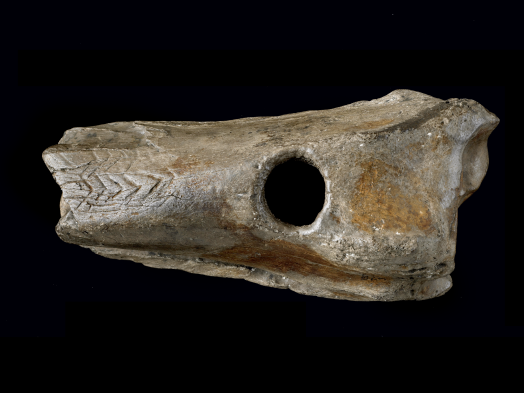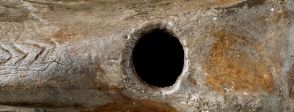
Using and working natural materials
An adze is a tool for working wood. This adze is made from the long bone, perhaps the thigh, of an aurochs, the huge wild cattle that roamed the forests of Mesolithic Britain. The bone has been chopped at an angle to form a cutting edge. It originally had a haft or handle, probably made of wood and secured with sinew or rawhide strips that contract and tighten when dry. It shows how its maker took advantage of materials available in the environment and of every opportunity that offered itself, using as many parts as possible of a hunted animal with each material suited to its particular job.
The importance of woodworking tools
Adze and axe heads can look similar. To tell the difference you need to work out how the tool was hafted – how the handle was attached. This adze has a hole in one end into which a wooden handle was fitted. The cutting edge, though broken, is clearly at right angles to the direction of the handle, making it an adze. Adzes and axes are well designed for their separate purposes, and humans across the world and through time have invented both tools when they needed to chop down trees and work wood. The cutting edge of an axe is aligned in the same direction as the handle and is used in a chopping manner. The cutting edge of an adze is usually at right angles to the handle and is used in a similar way to a pickaxe in order to smooth and shape a piece of wood. By the Mesolithic period, with the warming of the climate following the last Ice Age, Britain had become densely forested, These forests were the habitat for a wide range of animals to hunt. They provided foodstuffs such as hazelnuts, which were eaten in huge quantities, and also offered an abundant source of wood. Wood is a versatile raw material and made possible the manufacture of a range of objects difficult or impossible to make out of other materials. These objects included boats, like the later Bronze Age logboat in Object File: An early Iron Age boat which would have been hollowed out using an adze, and houses.
Decoration
It may seem odd to decorate such a functional object, but tools could have symbolic meanings too. This object had the power, if used properly, to transform a rough tree trunk into a usable piece of timber. The fact that it was made from the long bone of an aurochs probably also made it an object to carry around with pride. The decoration is similar to that found on adzes from Denmark, so it may be that the maker was from that area. Britain was still connected by a land bridge to the continent at the time when the adze was made.
More information
Overview of the period
A brief overview of the Mesolithic period from the Ashmolean Museum.
http://britisharchaeology.ashmus.ox.ac.uk/collections/mesolithic.html
Article about the period
A BBC article about the Mesolithic period by archaeologist Julian Richards.
http://www.bbc.co.uk/history/ancient/archaeology/oldest_house_01.shtml
Video introducing the period
A lively 5 minute video introduction to the Mesolithic period.
http://youtu.be/zDJvULjzjmk
Introduction to the period
An introduction to the Mesolithic period from the Young Archaeologists Club.
http://www.yac-uk.org/timeline/mesolithic
Video using an adze
A very short video showing a modern adze being used to smooth wood.
https://www.youtube.com/watch?v=2o5leRq4eyk
More information
-
Overview of the period
A brief overview of the Mesolithic period from the Ashmolean Museum.
Source: ashmus.ox.ac.uk
-
Article about the period
A BBC article about the Mesolithic period by archaeologist Julian Richards.
Source: bbc.co.uk
-
Video introducing the period
A lively 5 minute video introduction to the Mesolithic period.
Source: bettakultcha.com
-
Introduction to the period
An introduction to the Mesolithic period from the Young Archaeologists Club.
Source: yak-uk.org
-
Video using an adze
A very short video showing a modern adze being used to smooth wood.
Source: youtube user: chessbruno


